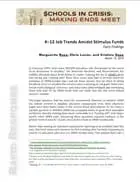In February 2009, with some 600,000 education jobs threatened by the worst fiscal downturn in decades, the American Recovery and Reinvestment Act (ARRA) allocated about $100 billion to states. Topping the list of ARRA’s goals was saving and creating jobs. Since then, states have had to provide quarterly estimates of ARRA-funded jobs, and yet these reports stop far short of telling the whole story on whether the stimulus plan is meeting its job goals. Some have voiced methodological concerns, and many have acknowledged that identifying those jobs paid for by ARRA funds does not imply that the jobs were indeed saved or created.
The larger question that has been left unanswered, however, is whether ARRA has indeed worked to stabilize education employment from what otherwise might have been heavy losses in the current fiscal environment. Or for some, a parallel question is whether ARRA has prompted states to grow their education workforce, thereby making them more vulnerable to a “funding cliff” with larger layoffs when ARRA ends. Answering these questions requires evidence of the greater trend in total K–12 jobs, not just the trends in ARRA-funded jobs.
Rather than waiting for standard employment reporting to be available later this year, this brief seeks early answers by first tracking what has been happening to total K–12 education jobs (not just ARRA-funded jobs). The analysis then uses a fiscal model to more reliably identify the number of jobs paid for with ARRA funds. Finally, the brief combines the data sets to answer the question of what role ARRA is playing in overall education employment.





